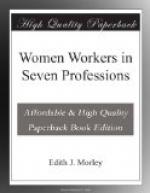With a view to standardising the training and diplomas of gymnastic teachers, the Ling Association in 1904 started a diploma-examination. Though the syllabus drawn up is practically the same as those used in the different colleges, most of the colleges still grant their own diplomas at the end of the course.
It is hardly possible at present, to specify the usual age of retirement for gymnastic teachers, but when a woman becomes too old for regular school teaching she can organise, supervise, and inspect, or continue to practise remedial work which includes massage.
Most of the gymnastic teachers who come within the scope of the Insurance Act have joined the University, Secondary and Technical Teachers’ Provident Society.
VII
THE TEACHING OF DOMESTIC SUBJECTS
There are several reasons why instruction in the domestic arts and in the management of a house has not until quite recently formed part of the curriculum in girls’ secondary schools. In the first years of the existence of these schools, no handicraft was encouraged except needlework, and this was soon almost crowded out of the time-table. It was assumed that household management was taught by the mother. There was a second assumption made even more confidently than the first, that a well-informed young woman with an active brain would find no difficulty in arranging her domestic affairs. This theory was founded on still another assumption—that there would always be on hire a sufficiency of servants already well trained for their work.
It is obvious nowadays that the mistresses of the first two decades of high-school teaching, being the first college-bred women, were suffering from a reaction against domestic interests, and the manner in which these had absorbed the old-fashioned woman. Their best pupils were at once destined for college; they were considered too good for mere domestic life, and were prepared for careers, mostly for teaching. This tendency was naturally accentuated by the fact that all mistresses were single women, with little prospect of any but a celibate life.
In the earlier stages of girls’ education, then, it was the teacher who urged the promising girl to have a career; but the more recent development is that the parents, harassed by increasing economic pressure, and encouraged by the instances they meet of successful professional women, press more and more strongly for their girls to be educated for professions, whether they are exceptionally gifted or not. It is recognised in almost all grades of the middle class that the chance of a daughter marrying, and, further, the chance of her marriage being an assured provision for her maintenance throughout life, is by no means a certainty.
These considerations must militate against the appearance of domestic subjects in the school time-table, but there are others working in exactly the opposite direction. These are the increase in house rent and general rise in prices which make economy in domestic affairs, and good management, more valued; the dearth of servants; and the decay of the old traditions of housekeeping. Another factor is the new cult of hygiene, and increased interest in diet, shown especially by the inhabitants of large towns, who bewail their lack of energy and fitness.




